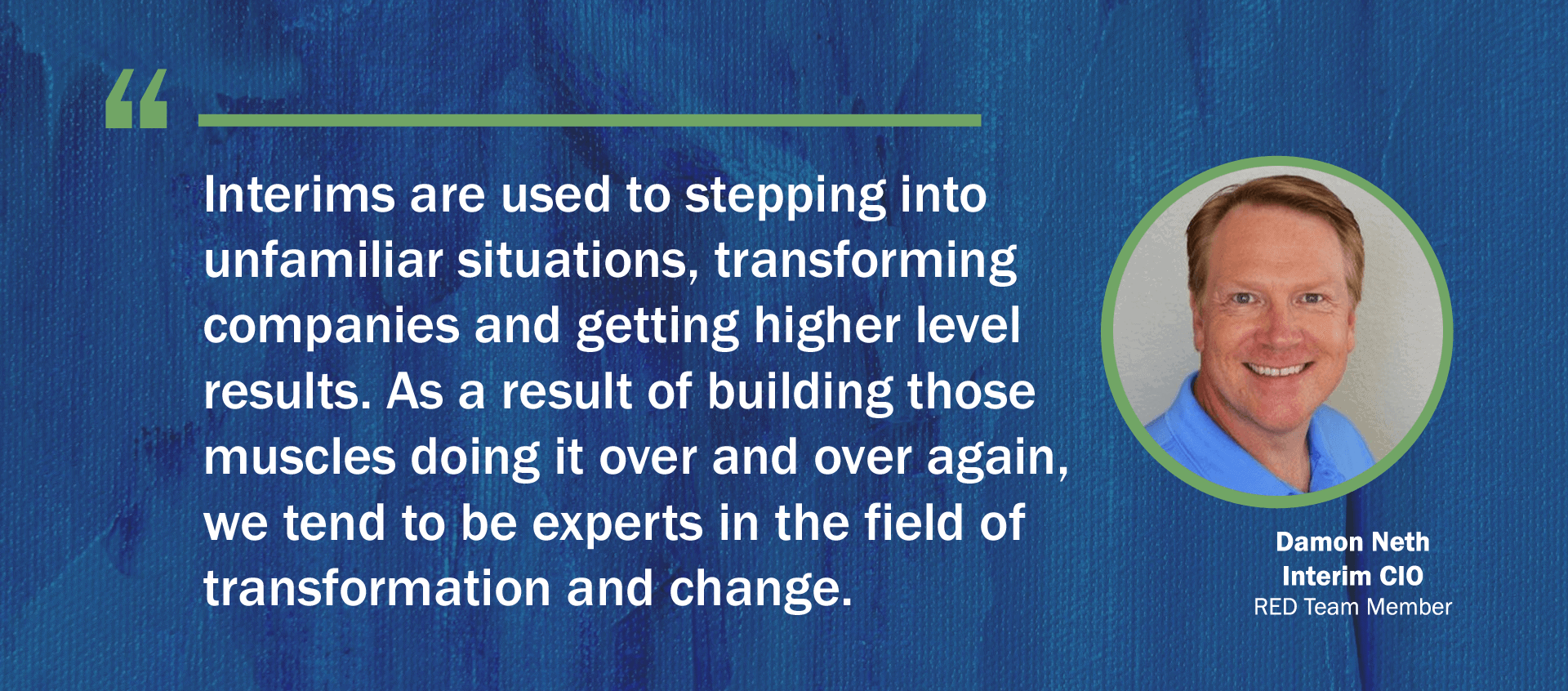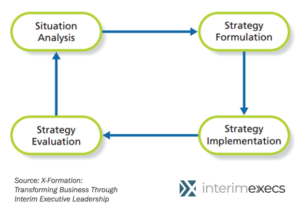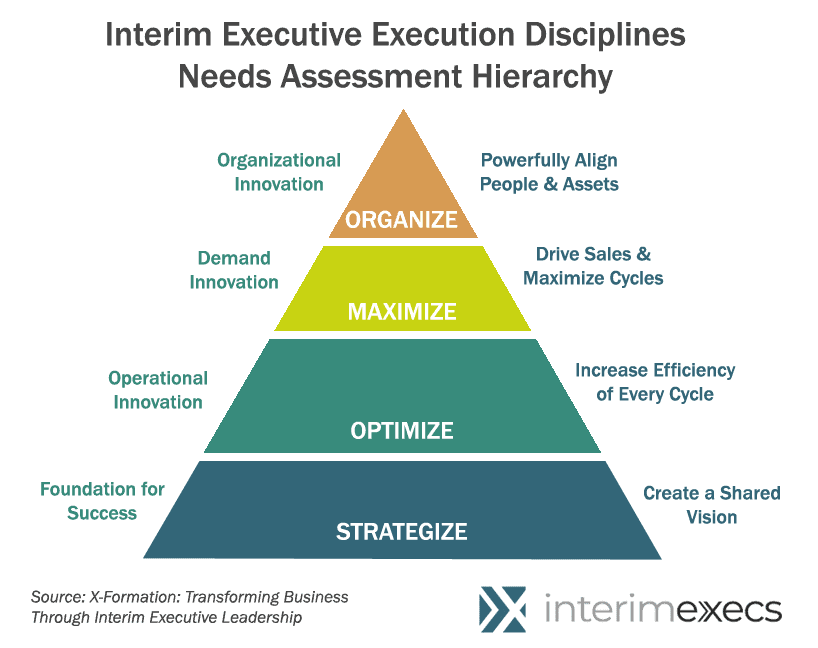How Do Interim Execs Approach Assignments?

Your Complete Guide to Interim Management — Chapter 5: How Do Interim Execs Approach Assignments?
05: How Do Interim Executives Approach Assignments?
Organizations considering engaging an interim executive are at some sort of inflection point. They might be facing a market disruption or launching a new product. Or they might be running out of runway and need immediate expertise to turn things around.
When time is of the essence, interims are the right answer. They are a specific breed of executive, people who are wired for action and focused on results. They understand the time value of money and bring a number of key characteristics to the engagement designed to create value rapidly:
▶ Interims are available almost immediately and can be on-site in a matter of days, much faster than contracting with a management consultant or hiring a new full-time executive.
▶ Interims are specialists in dropping into a crisis situation and know how to be effective from Day One.
▶ Interims have a track record of success, experience they bring to their next assignment, allowing them to be more effective faster.
▶ Interims are data-driven leaders who deliver measurable results quickly based on the company’s short- and long-term needs.
▶ Interims are teachers, coaches, and mentors who create lasting value for executive teams that benefit from the interim’s tutelage.
▶ Interims model great communication techniques and demonstrate transparency, bringing the team together.
▶ Interims maintain high professional standards as their future work relies upon referrals and a record of successful engagements.
▶ Interims are wired for success and have little interest in engagements where they do not feel they can be successful or add value.
▶ Interims know that time is money and are respectful of, but not encumbered by, company politics or culture. This allows them to move quickly and question openly.
▶ Interims bring new perspectives and focus on the immediate issues without biases from previous strategies.
▶ Interims have flexible contracts. InterimExecs interim agreements have 30-day termination clauses with no severance or benefits. In the unlikely event the interim is not a good fit, the organization or the interim can end the engagement with little fanfare and no severance costs.

The Complete Guide to Interim Management
-
- 01 What is an Interim Executive?
- 02 When is an Interim Manager the Right Choice?
- 03 When an Interim Executive is Not a Good Option
- 04 What’s the Difference Between an Interim Executive and a Consultant?
- 05 How do Interim Execs Approach Assignments?
- 06 Interim Executive Recruitment: Making the Right Match
- 07 The Process for Engaging an Interim Executive
- 08 How to Prepare Your Company for an Interim Leader

The Process for Engaging an Interim Executive
1) Define the time commitment
First, organizations need to know how much of an interim executive’s time they will need. If the company is in crisis or an executive suddenly departed and they need an interim to lead the transition, that will be a full-time-plus commitment. Conversely, if the company is in need of experienced leadership to guide growth, but they are not at the stage of needing a full-time leader, a a part-time executive can be a cost-effective way to get rock star leadership for a fraction of the cost. A fractional CFO or fractional COO, for example, will work a few hours a day or a few days a week in a full operational capacity. In these cases, the fractional executive could have multiple, parallel engagements running simultaneously.
2) Set goals, deliverables and expectations
Once you have identified the time commitment needed, it’s time for the owner, board, investors or CEO to take an honest look at issues or opportunities the interim will address and come up with a list of the goals and expectations they have for the assignment. You also will need to determine the length of the engagement and whether it is for a fixed duration, based upon the completion of key milestones, or a general timeline with check-in dates.
3) Find the right executive
Next, it’s time to begin interviewing potential interims. While it’s tempting to only consider executives with experience in your industry or business sector, that may not be the best approach. InterimExecs RED Team members, for example, tend to have a breadth of experience across specialties, industries, and business sectors. We believe that cross-pollination gives them a unique ability to use knowledge gained in one sector to find creative solutions to the challenges in another.
4) Negotiate the deal
Once you have chosen the right interim candidate, it’s time to negotiate the deal. Most likely, the interim will expect a cash-based fee for services rendered. If the assignment involves significant potential for upside to the company – either actions in saving or fixing assets, or creating new value – the interim executive may request a performance-based additional fee. In cases where the interim executive believes their efforts will result in orders of magnitude or creation of new value, they may request or require some form of equity, warrant, or other non-cash compensation.
In addition, many interims will be commuting to their temporary assignment. They will need a hotel, car, and meal reimbursement in addition to the management fee.
5) Assignment Kickoff
In some cases, interim executives begin by committing to an initial, short-term assessment or discovery project. That could take up to a month as the interim makes a frank assessment of the company and its current state and sets out a go-forward plan.
This initial assessment limits the risk the organization takes in contracting with the interim executive, and also allows the interim an opportunity to determine if the project represents a best use of her skills and abilities. If both sides agree, the interim then comes on board to implement the go-forward plan.
Whether work begins with an assessment or an open-ended agreement, it will commence on contract signing and fulfillment of any other upfront terms. Because interims believe in the “go anywhere, anytime” mantra, work can commence within days – far faster than any standard permanent hiring process.
Interims on the Job
Since the stakes are always high, Interims come prepared to get started by quickly assessing the health of major functions of the company, working cooperatively with others at all levels of the company to understand the full reality of the situation and developing action plans designed to deliver the highest value in the shortest amount of time.
As the old adage states, “Execution eats strategy for lunch.” This is particularly true for interims.
The needs of a typical organization can be broken down into four major areas, each of which interims approach from the perspective of “Execution.” The following diagram illustrates the four execution disciplines interims practice to assess needs and take action.
1) Strategize. While execution trumps strategy in the abstract, excellence in execution starts with sound strategy. A well-thought-out strategy lays out the vision for the project and the company.
2) Optimize. This step focuses on driving efficiency and reducing below-the-line expenses to increase bottom-line performance. This can take many forms but generally involves eliminating redundancy and inefficiency through process assessment and innovation.
3) Maximize. This step is all about maximizing the bottom line by scaling up to drive revenue growth.
4) Organize. This involves properly aligning a company’s people, assets, and processes to meet the strategy and goals outlined in the previous steps.
Continue Reading: Chapter 6 – Interim Executive Recruitment: Making the Right Match

FREE DOWNLOAD
Top Trends Driving the Growth of Interim Management
▶ 5: How do Interim Execs Approach Assignments?
▶ 6: Interim Executive Recruitment: Making the Right Match
▶ 7: The Process for Engaging an Interim Executive
▶ 8: How to Prepare Your Company for an Interim Leader


